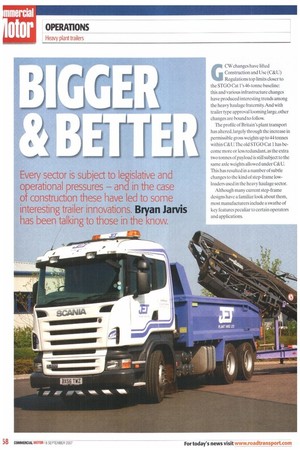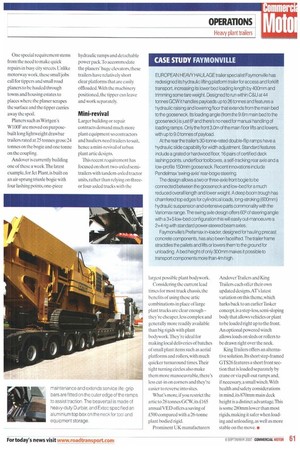Every sector is subject to legislative and operational pressures —
Page 58

Page 59

Page 60

Page 61

If you've noticed an error in this article please click here to report it so we can fix it.
and in the case of construction these have led to some interesting trailer innovations. Bryan Jarvis has been talking to those in the know.
GCW changes have lifted Construction and Use (C&U) Regulations top limits closer to the STGO Cat l's 46-tonne baseline: this and various infrastructure changes have produced interesting trends among the heavy haulage fraternity. And with trailer type approval looming large, other changes are bound to follow.
The profile of Britain's plant transport has altered, largely through the increase in permissible gross weights up to 44 tonnes within C&U.The old STGO Cat I has become more or less redundant, as the extra two tonnes of payload is still subject to the same axle weights allowed under C&U. This has resulted in a number of subtle changes to the kind of step-frame lowloaders used in the heavy haulage sector.
Although many current step-frame designs have a familiar look about them, most manufacturers include a swathe of key features peculiar to certain operators and applications. King Trailers' standard industry workhorse, the GTS 44, has become a popular choice among its STGO Cat 1 clients and many general 44-tonne operators. From the numbers sold, this model appears to offer regular midrange plant operators a durable general-purpose step-frame capable of handling a wide variety of equipment from tracked excavators and crushers through to access platforms and general wheeled equipment.
Like other trailer builders, King has a lengthy options list from which to tailor individual trailers to suit specific requirements. Spe.cialist variants include a GTS 38 step-frame version which, when deployed with a specific range of equipment, offers about 1,500kg more payload than the GTS 44.
For transporting larger crusher plant and demolition machines, the traditional hydroneck lowloader is often the right transport solution. But thanks to the plague of traffic-calming schemes and unilateral decisions being made by a number of local authorities to reduce the maximum axle weights permissible on their patch, there's a marked trend towards using low-loaders with full steering, and combinations with more axles rather than fewer.
The deck of King's latest 83tonne low-loader has been made lower; it also features other significant improvements.Whereas the typical three-axle low-loader operating in Cat 2 has a payload of around 47 tonnes, that load needs to be positioned accurately on the trailer bed if capacity at either end isn't to be wasted or the axle limits exceeded, so there are many details to be considered before reaching a final specification.
Expert advice
When calculations need to be made, manufacturers are always ready to offer expert advice; Nooteboom in particular provides an excellent service called Novab which is available via its website. This programme assists with calculating vehicle and axle loadings for most heavy haulage applications.Nooteboom's UK agency.Northarnpton-based HSE, supplies and supports its extensive product range, including the versatile Euro low-loader. This can have up to five axles with hydraulic steering, a removable gooseneck for front loading and a deep gully over the bogie to accommodate an excavator boom or boat hull.
Add a jeep or inter-dolly and extra axles and payloads can be boosted considerably too.
However, the shift towards using more axles has given a great deaf of prominence to trailers with four or more axles.
A popular example of this configuration is Andover Trailers' SFCL 67 stepped low-loader, built for Mason Brothers Plant Sales & Services of Narbeth, Pembrokeshire.
With a new Volvo FH13 520 tag-axle 6x2 up front, it's a sizeable £125.000 investment that will earn its keep ferrying crusher screen quarry plant between quarries and customers around West Wales and beyond.
The four-axled trailer incorporates a four-member frame and has two fixed axles, two selftrackers and one lifter. Standard fittings include powered toe ramps, steady legs and slide-out side extensions. But the ongoing construction boom has led many plant hauliers to look for more efficient ways of carrying plant and aerial-access equipment onto congested urban sites. One special requirement sterns from the need to make quick repairs in busy city streets. Unlike motorway work, these small jobs call for tippers and small road planers to be hauled through towns and housing estates to places where the planer scrapes the surface and the tipper carries away the spoil.
Planers such as Wirtgen's WIMP are moved on purposebuilt long lightweight drawbar trailers rated at 25 tonnes gross 24 tonnes on the bogie and one tonne on the coupling.
Andover is currently building one of these a week.The latest example, for Jet Plant, is built on an air-sprung triaxle bogie with four lashing points, one-piece hydraulic ramps and detachable power pack.To accommodate the planers' huge elevators, these trailers have relatively short clear platforms that are easily offloaded. With the machinery positioned, the tipper can leave and work separately.
Mini-revival
Larger building or repair contracts demand much more plant equipment so contractors and hauliers need trailers to suit, hence a mini-revival of urban plant artic designs.
This recent requirement has focused on short two-axled semitrailers with tandem-axled tractor units, rather than relying on threeor four-ayded trucks with the largest possible plant bodywork.
Considering the current lead times for most truck chassis, the benefits of using these artic combinations in place of large plant trucks are clear enough they're cheaper, less complex and generally more readily available than big rigids with plant bodywork.They're ideal for making local deliveries of batches of small plant items such as aerial platforms and rollers, with much quicker turnaround times.Their tight turning circles also make them more manoeuvrable, there's less cut-in on corners and they're easier to reverse into sites.
What's more, if you restrict the artic to 28 tonnes GCW, its £165 annual VED offers a saving of £500 compared with a 26-tonne plant bodied rigid.
Prominent UK manufacturers Andover Trailers and King Trailers each offer their own updated designs.AT's latest variation on this theme, which harks back to an earlier Tasker concept, is a step-less, semi-sloping body that allows vehicles or plant to be loaded right up to the front. An optional powered winch allows loads on sleds or rollers to be drawn right over the neck.
King Trailers offers an alternative solution. Its short step-framed GTS26 features a short front section that is loaded separately by crane Or via pull-out ramps and, if necessary, a small winch. With health and safety considerations in mind, its 870mm main deck height is a distinct advantage.This is some 280mm lower than most rigids, making it safer when loading and unloading, as well as more stable on the move. av
































































































































































































